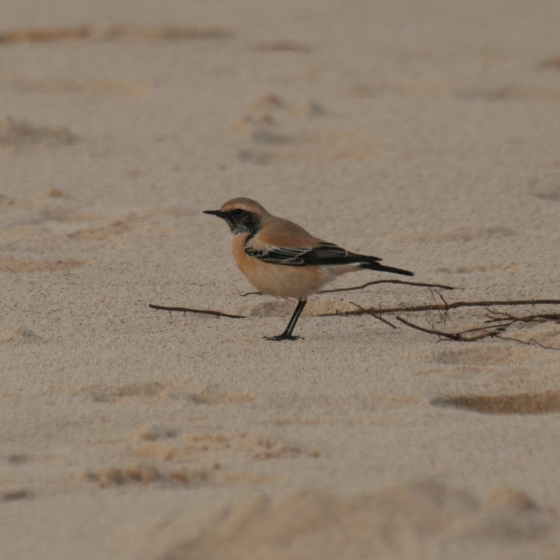Desert Wheatear

Introduction
Desert Wheatear is a rare visitor to Britain, and an even rarer one to Ireland. Most records come from the autumn period.

Key Stats
Status and Trends
Conservation Status
Population Size
Population Change
Population trends of this scarce species are not routinely monitored.
Distribution
This species is a rare vagrant and was recorded during Bird Atlas 2007–11 as shown on the map.
Occupied 10-km squares in UK
2007/08–10/11
or view it on Bird Atlas Mapstore.
European Distribution Map
Distribution Change
This vagrant is too rarely reported to map distribution change.
Seasonality
Desert Wheatear is a rare vagrant, typically appearing later than most other wheatears, in November and even December to February.
Weekly pattern of occurrence
The graph shows when the species is present in the UK, with taller bars indicating a higher likelihood of encountering the species in appropriate regions and habitats.

Movement
Britain & Ireland movement
Foreign locations of birds ringed or recovered in Britain & Ireland
Dots show the foreign destinations of birds ringed in Britain & Ireland, and the origins of birds ringed overseas that were subsequently recaptured, resighted or found dead in Britain & Ireland. Dot colours indicate the time of year that the species was present at the location.
- Winter (Nov-Feb)
- Spring (Mar-Apr)
- Summer (May-Jul)
- Autumn (Aug-Oct)

Biology
Survival and Longevity
Survival is shown as the proportion of birds surviving from one year to the next and is derived from bird ringing data. It can also be used to estimate how long birds typically live.
View number ringed each year in the Online Ringing Report.
Classification, names and codes
Classification and Codes
- Order: Passeriformes
- Family: Muscicapidae
- Scientific name: Oenanthe deserti
- Authority: Temminck, 1825
- BTO 5-letter code: DESWH
- Euring code number: 11490
Alternate species names
- Catalan: còlit del desert
- Czech: belorit pouštní
- Danish: Ørkenstenpikker
- Dutch: Woestijntapuit
- Estonian: kõrbe-kivitäks
- Finnish: aavikkotasku
- French: Traquet du désert
- German: Wüstensteinschmätzer
- Hungarian: sivatagi hantmadár
- Icelandic: Auðnadepill
- Irish: Clochrán Fásaigh
- Italian: Monachella del deserto
- Latvian: tuksneša cakstite
- Lithuanian: dykuminis kultupys
- Norwegian: Ørkensteinskvett
- Polish: bialorzytka pustynna
- Portuguese: chasco-do-deserto
- Slovak: skaliarik púštový
- Slovenian: pušcavski kupcar
- Spanish: Collalba desértica
- Swedish: ökenstenskvätta
- Welsh: Tinwen Diffeithwch
More Evidence
More evidence from Conservation Evidence.com
Partners
Citing BirdFacts
If you wish to cite particular content in this page (e.g. a specific value) it is best to use the original sources as linked in the page. For a more general citation of the whole page please use: BTO (20XX) BirdFacts Species: profiles of birds occurring in the United Kingdom. BTO, Thetford (www.bto.org/birdfacts, accessed on xx/xx/xxxx).

